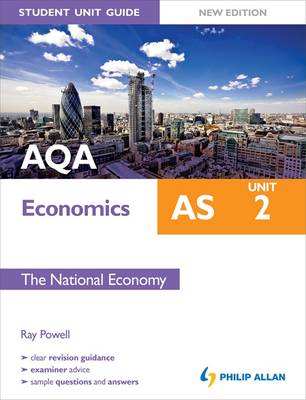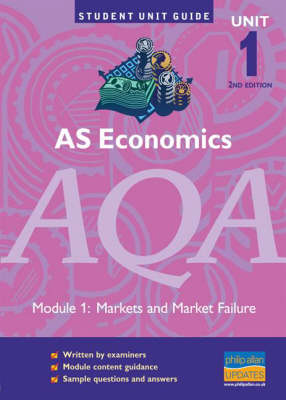Student Unit Guides
3 total works
This comprehensive text, written by Ray Powell, provides a thorough foundation for the A2 Economics course and is essential reading for AQA Economics students. The book provides detailed coverage of the content of the two A2 units, which focus respectively on microeconomics and macroeconomics. There is thorough coverage of topics that first appear at A2, together with an A2 treatment of topics such as market failure and AD/AS analysis that are common to both A2 and AS. - Improve understanding with clear definitions of key terms and concepts- Apply theory in a real-world context using case studies- Review questions can be used to assess understanding throughout the course- Sample exam-style questions, together with graded answers and detailed commentaries are available online at www.hodderplus.co.uk/philipallanCONTENTS: Introduction Chapter 1 How to become an even better economist Unit 3 Business economics and the distribution of income Chapter 2 Introduction to business economics Chapter 3 Production and cost theory Chapter 4 Revenue theory and market structures Chapter 5 Perfect competition and monopoly Chapter 6 Evaluating perfect competition and monopoly Chapter 7 Oligopoly and concentrated markets Chapter 8 Further aspects of the growth of firms Chapter 9 Industrial policy Chapter 10 Market failure Chapter 11 Government failure and cost-benefit analysis Chapter 12 Labour markets Chapter 13 Poverty and the distribution of income and wealth Unit 4 The national and international economy Chapter 14 Economic growth, development and standards of living Chapter 15 Developing the aggregate demand and aggregate supply macroeconomic model Chapter 16 Employment and unemployment Chapter 17 Inflation and the Phillips curve Chapter 18 Money, banks and monetary policy Chapter 19 Fiscal policy and supply-side policy Chapter 20 International trade and globalization Chapter 21 The balance of payments Chapter 22 Exchange rates, the pound, the dollar and the euro
AQA AS Economics Student Unit Guide: Unit 2 the National Economy
by Ray Powell
Published 30 January 2009
Perfect for revision, these guides explain the unit requirements, summarise the content and include specimen questions with graded answers.
Each full-colour New Edition Student Unit Guide provides ideal preparation for your unit exam: - Feel confident you understand the unit: each guide comprehensively covers the unit content and includes topic summaries, knowledge check questions and a reference index- Get to grips with the exam requirements: the specific skills on which you will be tested are explored and explained- Analyse exam-style questions: graded student responses will help you focus on areas where you can improve your exam technique and performance CONTENTS: Content Guidance - National income, economic growth and the economic cycle - Aggregate demand and the circular flow of income - The aggregate demand and aggregate supply macroeconomic model - Policy objectives and conflicts - Employment, unemployment, inflation and deflation - The balance of payments on current account - Fiscal policy - Monetary policy - Supply-side policies - Evaluating national economic performance Questions and Answers - The ECON 2 exam - The exam's assessment objectives - Answering objective-test questions - Answering data-response questions - The four key skills - Evaluation and levels of skills mark schemes - A strategy for tackling the examination - The exam questions in this Guide - Understanding UMS marks Objective-test questions Questions on Topics 1 to 10 Data-response questions Q1: Growth and recession Q2: Investment, productivity and macroeconomic performance Q3: Monetary policy and inflation Q4: Wages and inflation Q5: Fiscal policy and supply-side economics Q6: The UK's trade and economic slow-down
Each full-colour New Edition Student Unit Guide provides ideal preparation for your unit exam: - Feel confident you understand the unit: each guide comprehensively covers the unit content and includes topic summaries, knowledge check questions and a reference index- Get to grips with the exam requirements: the specific skills on which you will be tested are explored and explained- Analyse exam-style questions: graded student responses will help you focus on areas where you can improve your exam technique and performance CONTENTS: Content Guidance - National income, economic growth and the economic cycle - Aggregate demand and the circular flow of income - The aggregate demand and aggregate supply macroeconomic model - Policy objectives and conflicts - Employment, unemployment, inflation and deflation - The balance of payments on current account - Fiscal policy - Monetary policy - Supply-side policies - Evaluating national economic performance Questions and Answers - The ECON 2 exam - The exam's assessment objectives - Answering objective-test questions - Answering data-response questions - The four key skills - Evaluation and levels of skills mark schemes - A strategy for tackling the examination - The exam questions in this Guide - Understanding UMS marks Objective-test questions Questions on Topics 1 to 10 Data-response questions Q1: Growth and recession Q2: Investment, productivity and macroeconomic performance Q3: Monetary policy and inflation Q4: Wages and inflation Q5: Fiscal policy and supply-side economics Q6: The UK's trade and economic slow-down
Student Unit Guides are perfect for revision. Each guide is written by an examiner and explains the unit requirements, summarises the relevant unit content and includes a series of specimen questions and answers. There are three sections to each guide: Introduction - includes advice on how to use the guide, an explanation of the skills being tested by the assessment objectives, an outline of the unit or module and, depending on the unit, suggestions for how to revise effectively and prepare for the examination questions. Content Guidance - provides an examiner's overview of the module's key terms and concepts and identifies opportunities to exhibit the skills required by the unit. It is designed to help students to structure their revision and make them aware of the concepts they need to understand the exam and how they might analyse and evaluate topics. Question and Answers - sample questions and with graded answers which have been carefully written to reflect the style of the unit. All responses are accompanied by commentaries which highlight their respective strengths and weaknesses, giving students an insight into the mind of the examiner.


